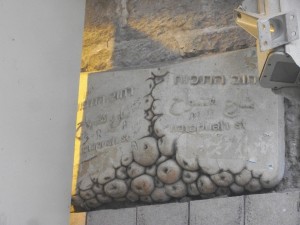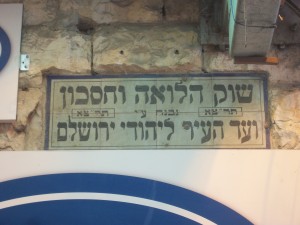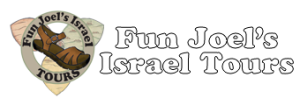
Following the early developments at Machane Yehuda Market through the first few decades of the 20th Century, the shuk found a permanent home in Jerusalem. This called for other changes that would solidify this permanence, over the decades of the mid-century.
Is There Only One Shuk at the Shuk?
As should be clear from the early history of the shuk, the changes and developments that occur in Machane Yehuda come about organically and due to necessity or external changes affecting the life of the city. Thus, the market developed and grew in stages, with at least 6 different sections built at different times by different groups of people.
(In a future post, I intend to include a complete, annotated map of the shuk, but until then, here is a link to a Google Map that includes most of the street names. I will use them as references in this next section, though some transliterations of Hebrew names are different on the map.)
Etz Chaim Shops
Adjacent and to the east of the market, along Yaffo Street, is a beautiful building that is currently slated to be turned into apartments or offices or something. This was once the Etz Chaim Yeshiva (a Jewish school for Torah study). As a way of raising money, in the 20s and 30s, they found donors who gave money to build shops along the eastern side of Valero’s field, and the yeshiva would then earn the rental income. These are the 40-or-so shops on Etz Chaim Street (aka “the covered shuk”), from Yaffo down to the passage into the parking lot area. I have not seen any, but I have read that behind the roofing, above the shops, there are many signs recognizing the original donors.
Apple and Pear
Following the initial laws enacted by the British, and their difficulty in meeting the British requirements in the makeshift market, a group of Jewish merchants appealed to the Vaad Ha’Ir, an organization that represented Jewish interests to the British. Following a 1922 letter, the Vaad helped these merchants purchase land from the Valero family, and loaned the merchants money for construction. The group of mainly Persian Jewish immigrants from the nearby Neve Shalom neighborhood built four parallel rows of shops facing in on what are the streets of HaTapuach and HaAgas (The Apple Street and its neighbor to the south, The Pear Street).
Savings and Loan Market
While this created a nice market with better quality, it also meant they needed to charge higher prices. They had trouble competing with the unregulated merchants still selling in the adjacent lot. This led to tensions between 1925 and 1930, with both groups appealing to the Vaad. Unfortunately, however, the Vaad no longer had money to help, and the peddlers themselves had less money than those who created Agas and Tapuach streets.

The British enforced standardized design on these shops, and the merchants organized with a set of rules. Only Jews were allowed to own or rent there, and they formed an owners organization. Today, there are signs with the name and founding date in Hebrew at the corner of HaShaked and Machane Yehuda and (partially broken) at the corner of Agrippas and HaEgoz.
The Iraqi Market
Also in 1931, another group wanted to establish a more permanent shuk. 22 sellers joined together and built Shuk Bet (Market “B”). It is located in the roughly C-shaped area to the west of Machane Yehuda Street. Later, since many of the merchants there were of Iraqi Jewish descent, the market became known as the Shuk HaIraqi. Yellow awnings mark the entrances from Machane Yehuda Street.
Kiach Shops
Just south of the Etz Chaim Yeshiva was the Kiach School. One of the first modern schools in Jerusalem, it was started by French Jews. The name Kiach is an acronym for the Hebrew words Kol Yisrael Chaverim (All Israel are Friends).
Taking a page from their northern neighbors’ book, they built stores as income property in the 1940s. Their shops run along the southern part of Etz Chaim Street (starting at the passage to the parking lot), turning and heading east on Agrippas.
Shuk HaGruzini
At the northern edge of the shuk, bounded roughly by Yaffo, Machane Yehuda, HaTapuach and Etz Chaim Streets, there is a central courtyard. Today it is best known for housing the Casino de Paris bar, and the backyard seating for Trattoria Haba (on Yaffo Street). But there are also many small shops there, as well as a central island of stands as well.
As far as I can tell, this area was not planned as a market in the same way as some of the others. For example, the Casino de Paris bar is on the ground floor of a building that was built as a hotel and events space of the same name. (More on that in a future post.) I am not certain when the shops began opening, but certainly by the 1970s, there were a number of merchants there of Georgian origin. Georgians are known in Israel as Gruzinim, and so the market has been referred to by that name as well ever since.
Have questions about Shuk Machane Yehuda? Leave a comment below, or contact me directly.
Click Here for Part 4 of “All You Want to Know About Machane Yehuda”

2 thoughts on “All You Want to Know About Machane Yehuda – Part 3: Building Permanence”